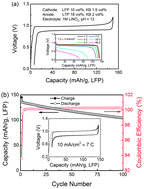Aqueous semi-solid flow cell: demonstration and analysis†
Abstract
An aqueous Li-ion flow cell using suspension-based flow electrodes based on the LiTi2(PO4)3–LiFePO4 couple is demonstrated. Unlike conventional flow batteries, the semi-solid approach utilizes fluid electrodes that are electronically conductive. A model of simultaneous advection and electrochemical transport is developed and used to separate flow-induced losses from those due to underlying side reactions. The importance of plug flow to achieving high energy efficiency in flow batteries utilizing highly non-Newtonian flow electrodes is emphasized.


 Please wait while we load your content...
Please wait while we load your content...